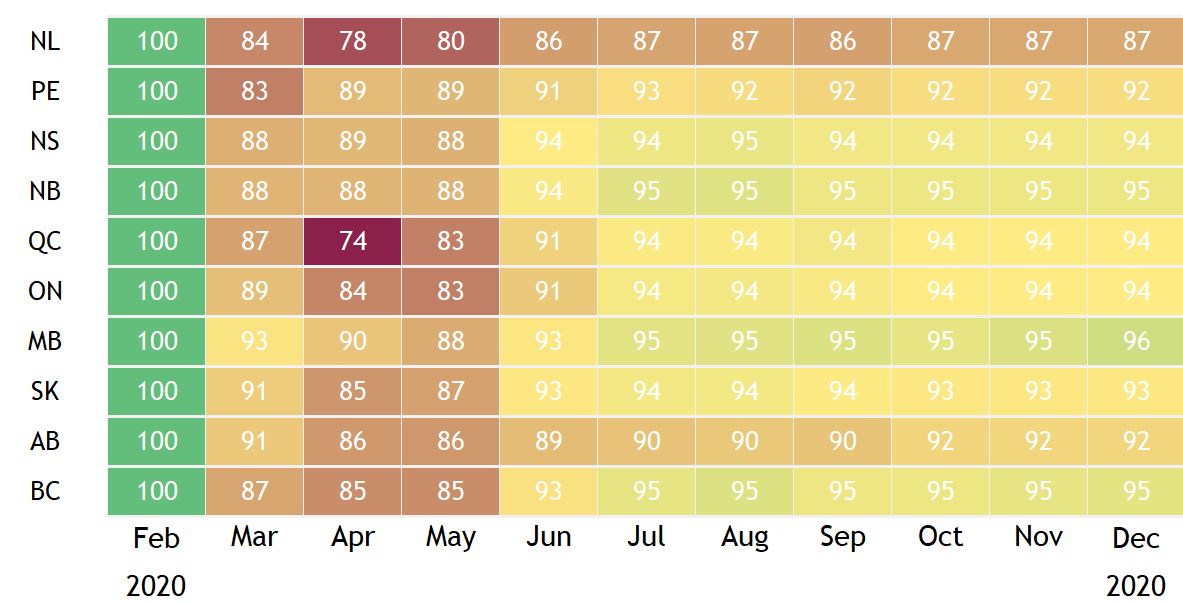The end of the Great Lockdown is still a long way away but we're seeing positive steps across Canada.
All provinces are now reopening parts of their economy gradually. And as they do, businesses are calling back laid-off workers and increasing work hours—getting the wheels of the economy spinning again. Barring any setbacks at containing the spread of COVID-19, we believe this reopening process will set the stage for a meaningful economic recovery over the second half of this year and into 2021. The pace of the recovery will be uneven across the country. Some provinces are proceeding a little more quickly than others with lifting lockdown restrictions—in part reflecting further progress at containing the pandemic. We believe this will give Manitoba, British Columbia and New Brunswick a head-start on the recovery. Low oil prices pose an additional hurdle for oil-producing provinces leaving Newfoundland and Labrador, Alberta and Saskatchewan as the weakest performers.
We have updated our provincial forecast based on data recently released and the latest government reopening plans. The main story hasn’t really changed from all interim updates since March—we expect all provincial economies to contract severely this year—though we now believe contractions won’t be quite as massive as we thought previously. The May labour report showed an earlier pick-up in jobs and hours worked than we anticipated for most provinces, which we believe marked the turning point. Other economic indicators—including housing starts and RBC’s proprietary consumer card spending data—also point to some near-term resilience or strengthening.
GDP recovery path assumptions
February 2020 = 100

The GDP recovery path we assume for most provinces now generally has a slightly higher cyclical bottom in April-May compared to our May Provincial Outlook Update. We expect Manitoba, BC and New Brunswick will recover the most ground lost by year-end, with Newfoundland and Labrador, Alberta and PEI trailing all provinces. Full recovery will be a long and bumpy road for all provinces—easily stretching into 2022 or beyond in some cases. The maintenance of some forms of social distancing, permanent business closures, weakened balance sheets and lower in-migration will restrain the economic rebound. We expect the impact of COVID-19 on some sectors like home construction will continue to grow well into 2021. Lower in-migration levels are poised to sap demand for new housing units, causing housing starts to fall in virtually every province next year. Still, despite many possible cross-currents, our forecast calls for positive economic growth to return from coast to coast in 2021—though this will say more about extremely low comparison point in 2020 than the degree of vitality in 2021.
Forecast details
% change unless otherwise indicated


Read report PDF
Robert Hogue is responsible for providing analysis and forecasts on the Canadian housing market and provincial economies. Robert holds a Master’s degree in economics from Queen’s University and a Bachelor’s degree from Université de Montréal. He joined RBC in 2008.
This article is intended as general information only and is not to be relied upon as constituting legal, financial or other professional advice. A professional advisor should be consulted regarding your specific situation. Information presented is believed to be factual and up-to-date but we do not guarantee its accuracy and it should not be regarded as a complete analysis of the subjects discussed. All expressions of opinion reflect the judgment of the authors as of the date of publication and are subject to change. No endorsement of any third parties or their advice, opinions, information, products or services is expressly given or implied by Royal Bank of Canada or any of its affiliates.


 Learn More
Learn More